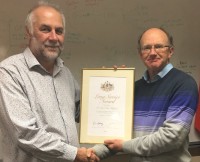Meteorologist still fired up about forecasting after 30 years
05/04/2018

Whether it is wind, rain, hail, thunderstorms, lightning, flooding or fires Tasmania has definitely
seen its fair share of standout weather.
And as he celebrates 30 years of service with the Bureau of Meteorology, Paul Fox-Hughes from
the High Impact Weather team says the constant advances in weather forecasting keep him
coming back for more.
"I think the two standouts would definitely be the satellite imagery and the astonishing
improvements in computer weather models that can seriously help us with our forecasting in
extreme weather situations," Dr Fox-Hughes said.
"The amount of information available when I started was much less than today, so we had less
understanding of what was currently occurring, let alone what was going to happen.
"For example, in the early 90s we had information coming through on a three hourly basis, today
it's every 10 minutes, and we had weather models that used grid spacing of 150 kilometre
resolution whereas today we can fine tune it down to 1.5 kilometre resolution."
Starting with the Bureau in 1988 as a 24-year-old, Paul has undertaken many roles including as a
forecaster for the Victorian office and the UK's Met Office, as well as roles as National Fire and Air
Quality Manager and stints with the Antarctic Climate and Ecosystems Cooperative Research
Centre.
He began specialising in severe weather forecasting from 1991 before moving into his current area
of High Impact Weather research in 2016.
"With high impact weather, it is very easy to see the value as it's very diverse," he said.
"Not only do you forecast some really interesting meteorological events, but you help in managing
its service and direction, meet with key users and help address their requirements, get to do some
research, and even get out of the office to look at where severe weather events have occurred."
When you ask him about some of the main events in Tasmania he will remember being a part of
severe weather incidents such as the 2011 floods in north Tasmania and the World Heritage Area
bushfires in 2016; however, it is the October 2006 eastern shore fire that he considers the most
extraordinary learning event during his three decades at the Bureau.
"From a meteorological point-of-view, that fire was a standout," he said.
"The highest fire danger was similar to that of the 1967 Black Tuesday fire, but actually lasted
much longer."
With so many learnings over the years and advancements coming every day it is no wonder Paul
says there is 'no way' he will retire anytime soon.
"I'm working with a great group of people committed to helping the community," he said.
"BoM is one of the leading national weather services in the world, and the difference we're able to
make to people's lives is amazing."
Photo caption: Paul Fox-Hughes (r) being presented with his 30-year long-service award by BOM's Tasmanian Antarctic Estate Manager, John Bally.
Please email media@bom.gov.au for more pictures.
ENDS…










